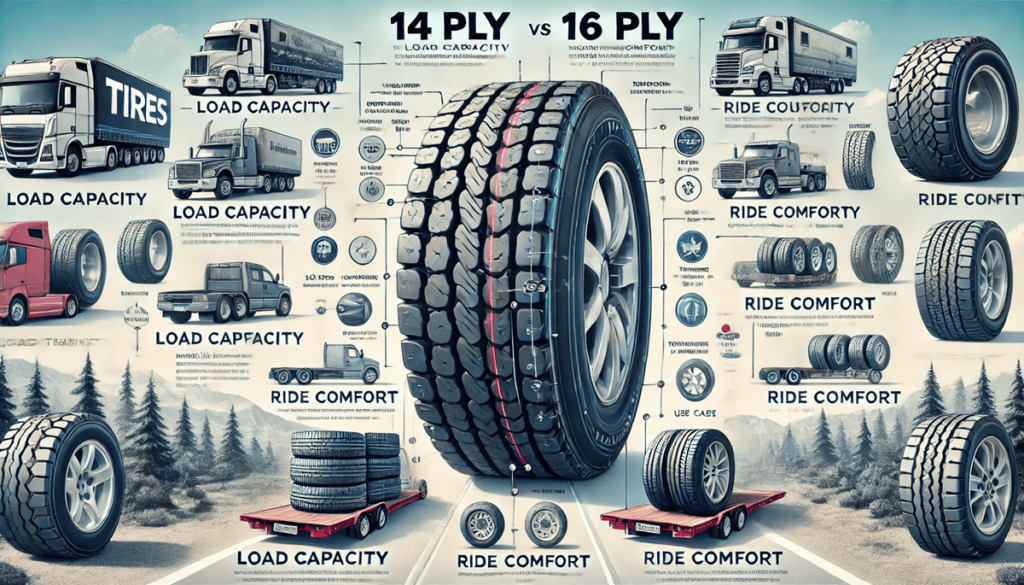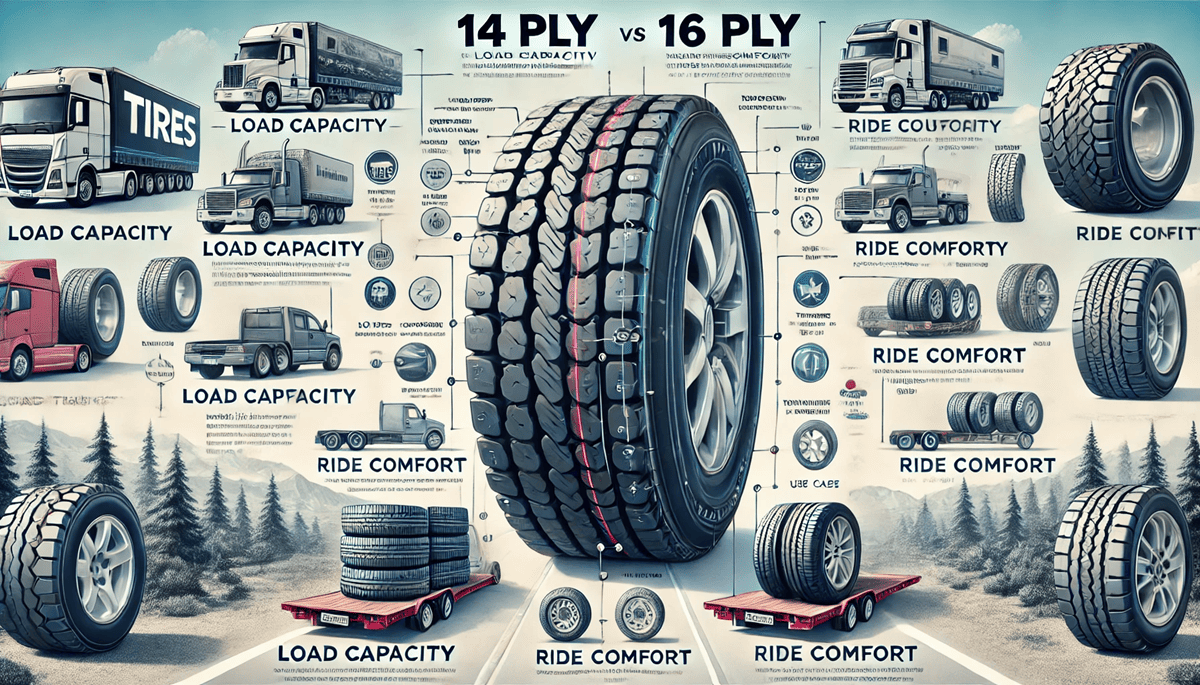
Choosing the right tire can be more complex than simply picking a brand or a size. If you’ve come across the terms “14 ply vs 16 ply” while searching for new tires, you’re likely wondering what the difference is and why it matters. Tires are a crucial part of your vehicle’s safety, efficiency, and comfort, and understanding ply ratings can help you make an informed decision. Whether you’re 🚚 hauling heavy loads across long distances or simply want to ensure a stable, comfortable 🚗 ride, selecting the right ply can be the difference between an ideal experience and constant struggles.
In this guide, we’ll break down the differences between 14 ply vs 16 ply tires in a way that’s easy to understand, and help you decide which is best for your specific needs.
Understanding Ply Ratings
Before diving into the differences between 14 ply vs 16 ply tires, it’s essential to understand what ply rating means. Originally, ply rating referred to the number of fabric layers, or plies, used to reinforce a tire. Back in the day, tires were constructed with layers of cotton to determine their strength—more plies meant a sturdier tire.
Today, with advancements in tire technology, the term “ply rating” doesn’t refer to actual physical plies anymore. Instead, it’s a measure of the tire’s load capacity and strength. Think of ply rating as an indicator of how much weight a tire can carry and how well it can handle stress. For example, a 14 ply-rated tire will have less load capacity compared to a 16 ply-rated tire.
Modern ply ratings are now often categorized by load ranges:
- 14 Ply Rating typically corresponds to Load Range G.
- 16 Ply Rating corresponds to Load Range H.
These ratings determine not just the strength of the tire, but also how much pressure they can handle. A higher ply rating usually means a more rigid tire that can carry more weight but may compromise on ride comfort.
14 Ply Tires: When Are They the Right Choice?
14 ply tires are a popular option for those who need something stronger than standard passenger tires but do not require the extreme capabilities of 16 ply tires. They are often found on trailers, light trucks, and RVs, offering a balance between load capacity and driving comfort.
Advantages of 14 Ply Tires:
- Better Ride Comfort: Compared to 16 ply tires, 14 ply vs 16 ply tires show that 14 ply tires generally provide a softer ride. The less rigid sidewall can help absorb road imperfections, offering a more comfortable experience, especially on long hauls.
- 💰 Cost-Effective: 14 ply tires are usually less expensive than their 16 ply counterparts. If your needs don’t demand the extra strength of a 16 ply tire, this could save you 💸.
- Adequate Load Capacity: For most uses, such as 🚛 hauling smaller trailers or 🛻 carrying moderate loads, 14 ply tires are more than sufficient.
Common Applications: Light-duty trailers, medium-sized RVs, and trucks that need to carry moderate loads. If you’re a weekend warrior towing a 🚤 or a camper, 14 ply tires are often the right choice.
Pros and Cons of 14 Ply Tires:
- Pros: Comfortable ride, lower cost, good load capacity for most light-duty tasks.
- Cons: Lower maximum load and durability compared to 16 ply tires.
16 Ply Tires: Heavy Duty and Built to Last
If you’re 🚚 hauling heavy loads or frequently driving on tough terrain, 16 ply tires might be the best option for you. These tires are built to handle more weight and are more resistant to punctures and wear, making them ideal for demanding conditions.
Benefits of Choosing 16 Ply Over 14 Ply:
- Higher Load Capacity: With a higher ply rating, 16 ply tires can manage significantly more weight. This makes them perfect for heavy-duty trucks, large trailers, and commercial vehicles.
- 📈 Increased Stability: The additional plies (or their modern equivalent) make these tires stiffer, which helps improve stability—particularly useful when towing large trailers on the highway.
- 💪 Durability: The added rigidity of 16 ply tires makes them more resistant to punctures and damage, which is crucial for construction vehicles or trucks frequently traveling off-road.
Use Cases: Heavy-duty trucks, large fifth-wheel trailers, and commercial vehicles. If you’re a contractor towing equipment or hauling significant weight, the extra durability and stability of 16 ply tires are invaluable.
Pros and Cons of 16 Ply Tires:
- Pros: Higher load capacity, increased durability, better stability for towing.
- Cons: More expensive, stiffer ride compared to 14 ply, less comfort.
14 Ply vs 16 Ply: A Detailed Comparison
To give you a clearer picture of how 14 ply vs 16 ply tires compare, let’s break down their characteristics across several important aspects:
| Feature | 14 Ply Tires | 16 Ply Tires |
|---|---|---|
| Load Capacity | Moderate load capacity | High load capacity |
| Ride Comfort | Softer ride, more comfortable | Stiffer ride, less comfort |
| Cost | Generally more affordable | Higher cost |
| Durability | Suitable for moderate use | Highly durable, ideal for heavy use |
| Stability | Good for lighter towing | Excellent for heavy towing |
| Common Use | RVs, small trailers, light trucks | Large trailers, commercial vehicles |
From the table above, it’s evident that the choice between 14 ply vs 16 ply depends largely on your specific needs. If your priority is comfort and cost-efficiency, and you’re dealing with moderate loads, 14 ply tires may be ideal. However, if you need maximum durability and load capacity, 16 ply tires are likely the better option.
Factors to Consider When Choosing Between 14 and 16 Ply
1. 🚗 Vehicle Type and Usage
Are you driving a heavy-duty pickup or a light trailer? Your vehicle type will largely determine what ply rating makes sense. Heavier trucks often need the additional load capacity that 16 ply tires offer.
2. 🏞️ Terrain and Conditions
If you’re frequently driving off-road, on construction sites, or on poorly maintained roads, 16 ply tires are more resistant to punctures and cuts. However, for mostly 🛣️ highway driving, 14 ply tires may offer a better balance of comfort and performance.
3. 🚛 Towing and Load Requirements
Consider the weight you’re planning to tow or carry. A 16 ply tire can handle heavier loads, which means they’ll last longer under stress compared to 14 ply tires. If you’re pushing your vehicle’s maximum load capacity, opting for a higher ply rating is advisable.
Real-Life Example: Choosing Between the Two
Imagine you own a landscaping business and need to tow heavy equipment to different job sites. You have a choice between 14 ply and 16 ply tires for your trailer. In this scenario, 16 ply tires would be the better choice because of the increased load capacity and stability. Alternatively, if you’re an RV enthusiast who enjoys taking weekend trips with a light camper, 14 ply tires would be more than enough, giving you a comfortable ride without overspending.
FAQs: Answering Common Questions
Do 16 Ply Tires Last Longer Than 14 Ply?
Yes, generally speaking, 16 ply tires last longer, especially under heavy loads. Their increased rigidity means they are less prone to wear and tear.
Is a 16 Ply Always Better for Towing?
Not necessarily. While 16 ply tires offer more stability, they may be overkill for smaller, lighter trailers. Assess your load requirements before making a decision.
What About Fuel Efficiency?
Since 16 ply tires are heavier and stiffer, they can slightly reduce fuel efficiency compared to 14 ply tires. However, this difference is often minimal and depends on your specific vehicle and driving conditions.
Which is Better for Off-Road Driving, 14 Ply or 16 Ply?
For off-road driving, 16 ply tires are usually the better choice due to their added durability and resistance to punctures. The stronger construction means they can handle rough and rocky terrain better than 14 ply tires. However, if you are not carrying significant weight, 14 ply tires might still be sufficient while providing a more comfortable ride.
Are 14 Ply Tires Good for Long-Distance Travel?
Yes, 14 ply tires can be a good choice for long-distance travel, especially if you are not hauling heavy loads. They provide a softer and more comfortable ride, which can reduce driver fatigue during long hours on the road. However, if you need to carry heavier cargo, 16 ply tires might be a better fit for their increased stability and load capacity.
Can I Replace 14 Ply Tires with 16 Ply Tires?
In many cases, you can replace 14 ply tires with 16 ply tires, but you need to make sure your vehicle can handle the higher ply rating. The increased stiffness and weight may impact ride quality, and your vehicle should be rated for the higher load capacity that comes with 16 ply tires. Always consult with a tire professional before making such a change to ensure compatibility and safety.
Practical Tips for Choosing the Right Tire
- Match Your Tire to Your Vehicle and Needs: Always check the manufacturer’s recommendations regarding ply rating. Overkill can lead to unnecessary expenses.
- Read Tire Markings: Tire markings provide crucial information about load range and ply rating. Ensure you understand these to pick the right tire.
- Consult an Expert: When in doubt, consult a tire specialist who can provide personalized advice based on your specific vehicle and needs.
Conclusion
When it comes to choosing between 14 ply vs 16 ply tires, the decision ultimately boils down to your specific needs. Are you towing heavy loads and need maximum durability? Go with 16 ply. Do you value comfort and cost-effectiveness for light to moderate towing? Then 14 ply is likely the better choice.
Whether you choose 14 ply vs 16 ply, make sure to consider your vehicle type, typical load, and the conditions you’ll be driving in. Remember, you don’t have to make this decision alone—reach out to a tire specialist or join a community of fellow drivers to share experiences and get valuable insights.
Ready to make your decision? Feel free to consult a tire expert or join an online forum to get personalized recommendations! 🚙💨
